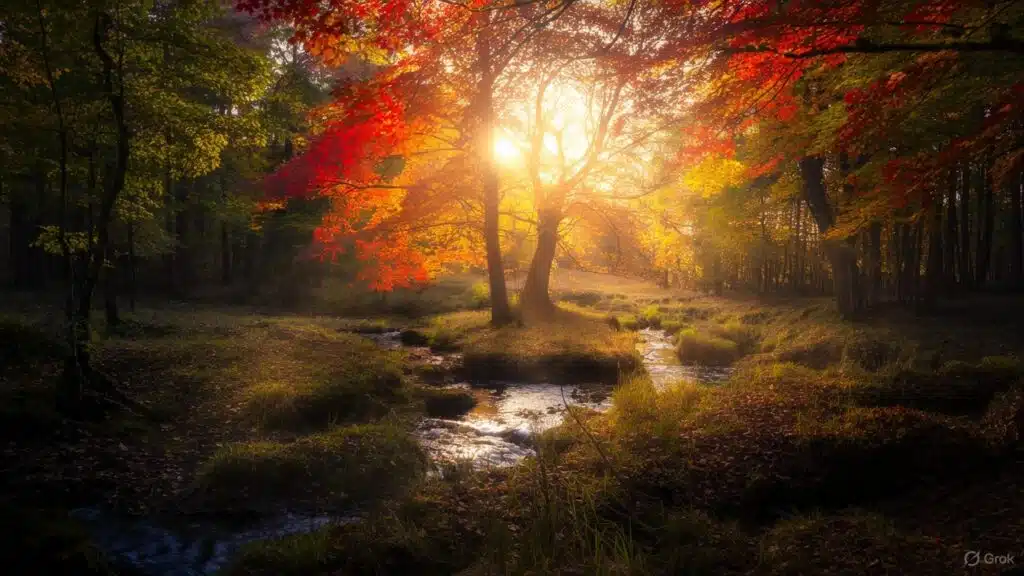The Magic of Autumn
Have you ever walked outside on a cool autumn day and noticed the trees glowing with bright red, orange, and yellow leaves? It almost feels like nature is painting the world in warm colors before winter arrives. But why do leaves change color in autumn? Do trees do it for fun? Is it magic? Or is there science behind it?
Let’s take a journey into the colorful world of autumn and discover how and why this transformation happens.
The Role of Leaves in Summer
To understand autumn, we need to go back to summer. In summer, leaves are usually green. That’s because they contain a special chemical called chlorophyll.
Chlorophyll is like the tree’s “food factory.” It helps leaves absorb sunlight and turn it into food through a process called photosynthesis. With sunlight, water, and carbon dioxide, trees create sugar that gives them energy to grow tall, strong, and leafy.
That’s why summer forests look so lush and green — the leaves are hard at work making food!
What Happens When Autumn Arrives?
When autumn comes, the days grow shorter, and the temperature drops. Trees sense that winter is coming, and they need to prepare.
Winter is too cold for trees to make food the same way they do in summer. So instead of keeping their leaves alive, trees begin to “shut down” their food factories.
- Chlorophyll breaks down, and the green color slowly fades away.
- Other colors that were always hiding inside the leaves start to show!
It’s like the green curtain of chlorophyll is lifted, and suddenly we see the brilliant reds, oranges, and yellows that were there all along.
The Secret Colors Inside Leaves
So, what colors appear, and why?
- Yellow and Orange – These colors come from chemicals called carotenoids. They’re the same pigments that make carrots orange and bananas yellow!
- Red and Purple – These come from anthocyanins, which are special pigments that can form in autumn. They act like sunscreen for the leaves, protecting them as they break down.
- Brown – This color is left behind when the leaf is completely dying and drying out.
Each tree species has its own “color style.” Maple trees often turn bright red, birch trees become golden yellow, and oaks usually go brown.
🍂 Fun Fact: Did You Know?
Not all trees lose their leaves in autumn! Evergreen trees like pines and firs keep their green needles all year round because they have a different way of surviving winter.
Why Do Trees Drop Their Leaves?
Changing colors is only part of the story. After showing off their bright coats, leaves eventually fall to the ground. But why?
The reason is simple: survival.
- During winter, frozen ground makes it hard for trees to get water.
- If trees kept their leaves, the leaves would lose too much water into the cold, dry air.
- By dropping leaves, trees “close shop” for winter and save energy until spring.
The fallen leaves also help the ground. As they rot, they return nutrients to the soil, making it rich and healthy for new growth.

How Animals Use Autumn Leaves
Leaves aren’t just pretty — they’re useful!
- Squirrels and chipmunks hide nuts under piles of leaves to keep them safe.
- Bugs and insects crawl into leaf piles for warmth during winter.
- Deer and other animals eat fallen leaves when food is scarce.
In a way, autumn leaves create a blanket that protects the forest until warmer days return.
The Science Behind the Timing
Not all places in the world see autumn the same way.
- In cooler regions, like parts of North America and Europe, autumn colors are super bright.
- In warmer or tropical areas, leaves don’t change color much because trees don’t face harsh winters.
Scientists say the exact timing of color change depends on:
- Temperature – Cool nights and sunny days make the best reds and purples.
- Rainfall – Too much or too little rain can affect how bright the colors appear.
- Tree type – Some trees simply don’t produce much pigment.
That’s why no two autumns look exactly the same!
A Global Festival of Colors
Every autumn, people travel far and wide to see the beauty of fall. In the U.S., states like Vermont and New Hampshire are famous for their glowing hills. In Japan, people celebrate “Momijigari,” the tradition of admiring colorful maple leaves.
It’s almost like Earth throws a party before winter arrives — with leaves as the decorations!
🍂 Story Time: The Legend of the Autumn Leaves
Long ago, some cultures told stories about why leaves change color. One Native American legend says that the red color comes from the blood of a great battle in the sky between good and evil spirits. Another tale says the colors are gifts from the sun, thanking the trees before winter’s darkness.
While science explains the colors with chlorophyll and pigments, the stories remind us that autumn has always felt magical to humans.

How You Can Enjoy Autumn
If you live in a place with autumn, here are some fun activities to try:
- Collect different colored leaves and press them into a scrapbook.
- Make leaf art by tracing shapes and coloring them.
- Jump into a big pile of fallen leaves (super fun, but check for sticks first!).
- Go on a “color walk” and count how many shades of red, yellow, and orange you can find.
Even if you live somewhere without autumn, you can still explore photos and videos of this amazing season online and learn about the science behind it.
Conclusion: Nature’s Colorful Goodbye
So, why do leaves change color in autumn? Because trees are preparing for winter by shutting down their food factories, letting their hidden pigments shine, and then dropping their leaves to survive the cold.
It’s a mix of science and beauty — a reminder that nature is always changing, always adapting, and always giving us something wonderful to see.
Next time you see a bright red or golden leaf, remember: it’s not just pretty, it’s part of a bigger story about how trees live and survive.

